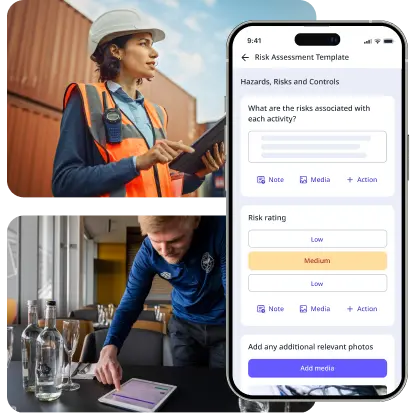What is ISO 14001 Template?
ISO 14001 is an international standard in designing and implementing environmental management systems (EMS) that organizations can voluntarily certify for. ISO 14001 certification enhances green credentials, which subsequently boosts business image, improves cost control, and reduces accidents or incidents caused by environmental factors.
Importance of ISO 14001 Checklists
A well-designed ISO 14001 checklist can help environmental, health, and safety (EHS) managers stay on top of compliance requirements and double down efforts on effective implementation. It is crucial for organizations to continue using, modifying, and updating their ISO 14001 template to demonstrate dedication in validating their environmental management system consistently.
When it comes to selecting the right ISO 14001 checklist for your business, there are a few key factors to consider. First, you should assess your current environmental management system (EMS) to determine which parts of the ISO 14001 standard are most relevant to your organization.
There are a variety of ISO 14001 checklists available, so it’s important to take the time to find one that will fit well with your EMS. Once you’ve selected the right ISO 14001 checklist for your business, you can begin working on employing it. Remember, the goal is to use the checklist as a tool to help you improve your EMS. Don’t try to use the checklist as a replacement for your EMS. If you do, you’ll likely find it difficult to maintain compliance with the standard.
Complying with ISO 14001 Requirements
ISO 14001 compliance is the bare minimum of an environmental management system that actually works. Being ISO 14001-certified entails specific compliance obligations as explained in Annex A of the ISO 14001:2015 standard—mandatory legal requirements related to an organization’s environmental aspects can include, if applicable:
- requirements from governmental entities or other relevant authorities;
- international, national and local laws and regulations;
- requirements specified in permits, licenses or other forms of authorization;
- orders, rules or guidance from regulatory agencies; and
- judgments of courts or administrative tribunals.
The guidance on the use of ISO 14001:2015 standard further states that compliance obligations also include other interested party requirements related to its environmental management system which the organization has to or chooses to adopt which can include, if applicable:
- agreements with community groups or non-governmental organizations;
- agreements with public authorities or customers;
- organizational requirements;
- voluntary principles or codes of practice;
- voluntary labeling or environmental commitments;
- obligations arising under contractual arrangements with the organization; and
- relevant organizational or industry standards such as the Business Social Compliance Initiative (BSCI) and Good Manufacturing Practices (GMP), among others.
How to Implement ISO 14001
During implementation of ISO 14001, adhering to the Plan-Do-Check-Act cycle (PDCA) can organize EMS processes and help organizations meet the standard in proper order. The PDCA cycle can be simplified into 4 easy-to-follow steps:
- Plan – Plan environmental performance evaluation by selecting relevant indicators. Use a comprehensive checklist to ensure that auditors thoroughly investigates during data collection.
- Do – Collect and analyze data, assess information, and report results. This step involves implementing the planned EMS and operational controls
- Check – Conduct a performance evaluation and management review
- Act – Implement and ensure that corrective actions are completed
After going through the PDCA cycle, you may modify your EMS based on the data gathered :
FAQs about ISO 14001
What are the requirements of ISO 14001?
Is ISO 14001 a legal requirement?
What are the five elements of ISO 14001?




